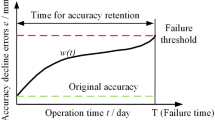Abstract
When machining complex geometries on five-axis machining centres, the orientation and positioning of the workpiece in the machine workspace are generally chosen arbitrarily by the operator from the Computer-Aided Manufacturing software. Nevertheless, these two factors have considerable influence on the machining time. The present article firstly studies the choice of workpiece orientation. Relying on analysis of the machine’s kinematic behaviour, orientations of the workpiece in the machine workspace are proposed minimising the overall distance travelled by the rotary axes. Secondly, choice of workpiece positioning in translation is studied. To this purpose, the work volume in five-axis machining is identified so as to avoid overshooting the machine travels when the program is executed. The optimum positioning is chosen to minimise the overall distance covered by the machine’s axes of translation. Finally, the proposed method provides for a workpiece setup to be adopted that minimises the distances covered by the machine axes. This leads to reduced machining time with concomitant gains in productivity and greater respect for the cutter/workpiece relative feed rate for enhanced quality.
Similar content being viewed by others
References
Hock S (1997) High speed cutting in die and mould manufacture, First French and German Conference on High Speed Machining, pp. 274–283
Erkorkmaz K, Altintas Y (2001) High speed CNC system design. Part I: jerk limited trajectory generation and quintic spline interpolation. Int J Mach Tools Manuf 41:1323–1345
Bagard P (1997) Tooling and complex shapes: technico-economic reports between high speed machining, conventional machining and electroerosion, First French and German Conference on High Speed Machining, pp. 249–259
Tönshoff H, Rackow N (2000) Optimal tool positioning for five axis flank milling of arbitrary shaped surfaces. Annals Ger Acad Soc Prod Eng 7:57–60
Vickers GW, Quan KW (1989) Ball-mills versus end-mills for curved surface machining. J Eng Ind ASME Trans 111:22–26
Rubio W, Lagarrigue P, Dessein G, Pastor F (1998) Calculation of tool paths for a torus mill on free-form surfaces on five-axis machines with detection and elimination of interference. Int J Adv Manuf Technol 14:13–20
Jun CS, Cha K, Lee YS (2003) Optimizing tool orientations for 5-axis machining by configuration space search method. Comput Aided Des 35:549–566
Monies F, Rubio W, Redonnet JM, Lagarrigue P (2001) Comparative study of interference caused by standard and improved positioning of a conical milling cutter working on a ruled surface. J Eng Manuf 215:1305–1317
Senatore J, Landon Y, Rubio W (2008) Analytical estimation of error in flank milling of ruled surfaces. Comput-Aided Des 40:595–603
Chaves-Jacob J, Poulachon G, Duc E (2009) New approach to 5-axis flank milling of free-form surfaces: computation of adapted tool shape. Comput-Aided Des 41:918–929
Tournier C, Duc E (2005) Iso-scallop tool path generation in 5-axis milling. Int J Adv Manuf Technol 25:867–875
Senatore J (2007) Analyse qualitative des paramètres influents pour la planification des trajectoires sur surfaces gauches, Thèse de doctorat, Université de Toulouse
Poeschl T (1984) Detecting surface irregularities using isophotes. Comput Aided Geom Des 1:163–168
Anotaipaiboon W, Makhanov S (2008) Curvilinear space-filling curves for five-axis machining. Comput–Aided Des 40:350–367
Senatore J, Monies F, Redonnet J, Rubio W (2005) Analysis of improved positioning in five-axis ruled surface milling using envelope surface. Comput–Aided Des 37:989–998
Lartigue C, Duc E, Affouard A (2003) Tool path deformation in 5-axis flank milling using envelope surface. Comput–Aided Des 35:375–382
Pechard P, Tournier C, Lartigue C, Lugarini J (2009) Geometrical deviations versus smoothness in 5-axis high-speed flank milling. Int J Mach Tools Manuf 49:454–461
Lavernhe S (2006) Prise en compte des contraintes associées au couple MO–CN en génération de trajectoires 5 axes UGV, Thèse de doctorat, École Normale Supérieure de Cachan
Pessoles X, Landon Y, Rubio W (2010) Kinematic modelling of a 3-axis NC machine tool in linear and circular interpolation. Int J Adv Manuf Technol 47:639–655
Pessoles X, Landon Y, Mousseigne M, Rubio W (2010) Simulation of the behaviour of CNC machine-tools in 3-axis milling of sculptured surfaces. Int J Mach Mach Mater 8:326–338
Lavernhe S, Tournier C, Lartigue C (2008) Optimization of 5-axis high-speed machining using a surface based approach. Comput–Aided Des 40:1015–1023
Castagnetti C, Duc E, Ray P (2008) The Domain of Admissible Orientation concept: a new method for five-axis tool path optimisation. Comput–Aided Des 40:938–950
Sorby K (2007) Inverse kinematics of five-axis machines near singular configurations. Int J Mach Tools Manuf 47:299–306
Bohez E (2002) Five-axis milling machine tool kinematic chain design and analysis. Int J Mach Tools Manuf 42:505–520
Anotaipaiboon W, Makhanov S, Bohez E (2006) Optimal setup for five-axis machining. Int J Mach Tools Manuf 46:964–977
Shaw D, Ou G (2008) Reducing X, Y and Z axes movement of a 5-axis AC type milling machine by changing the location of the work-piece. Comput–Aided Des 40:1033–1039
Pessoles X (2010) Aide au choix du posage en usinage 5 axes continus par la modélisation du comportement cinématique des machines—outils, Thèse de doctorat, Université de Toulouse
Kadirgama K, Noor MM, Zuki NM, Rahman MM, Rejab MRM, Daud R, Abou-El-Hossein KA (2008) Optimization of surface roughness in end milling on mould aluminium alloys (AA6061-T6) using response surface method and radian basis function network. Jordan J Mech Ind Eng 2:209–214
Author information
Authors and Affiliations
Corresponding author
Rights and permissions
About this article
Cite this article
Pessoles, X., Landon, Y., Segonds, S. et al. Optimisation of workpiece setup for continuous five-axis milling: application to a five-axis BC type machining centre. Int J Adv Manuf Technol 65, 67–79 (2013). https://doi.org/10.1007/s00170-012-4151-y
Received:
Accepted:
Published:
Issue Date:
DOI: https://doi.org/10.1007/s00170-012-4151-y




